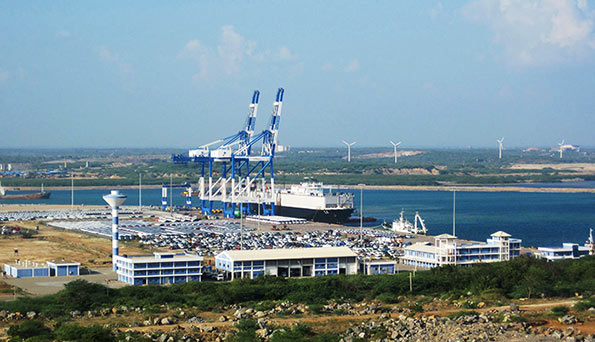Sri Lanka finalizing controversial port sale to China

Sri Lanka’s prime minister is meeting with government officials this week to finalize details of the controversial sale of a majority stake in Hambantota Port to China.
Sri Lanka is selling an 80 percent stake in the port to state-owned China Merchants Ports Holdings for $1.12 billion for a period of 99 years. China is also being given a long-term lease on 15,000 hectares (37,100 acres) of land close to the port to develop an industrial zone intended to be a primary source of cargo for terminals at the port.
The industrial zone would help Hambantota, which predominantly handles roll-on, roll-off cargo and is located about 250 kilometers (155 miles) southeast of the Port of Colombo, increase the use of its modern container cranes.
The cash-strapped government is determined to press ahead with the deal despite heavy public opposition over increasing levels of Chinese investment and asset and land ownership in the South Asian country, and Prime Minister Ranil Wickremesinghe is due to visit Beijing in May to attend a Belt and Road summit as the two countries pursue a free trade agreement.
The prime minister is due to meet with a cabinet to finalize details of the agreement, which was originally due to be completed in early January but was delayed amid mounting public protests against the sale.
An early January protest involving port workers, villagers, and Buddhist monks erupted in violence as the prime minister and Chinese ambassador Yi Xianliang launched the industrial zone, which is seeking investment from Chinese companies.
“Our main objective is to force the government to cancel the agreement and to retain ownership of the Hambantota Port,” said Deputy General Secretary of the Ceylon Ports General Employees Union G. Niroshan.
“The government is attempting to hand over 15,000 hectares of land to Chinese companies, which would virtually turn Hambantota into a Chinese colony,” he said.
At the end of last year port workers forcibly held a K-Line car carrier, Hyperion Highway, and its crew for five days after which the Japanese company handed Sri Lanka a bill for $400,000 to cover damages incurred.
Politicians opposing the sale of the port say the deal was poorly planned, and questioned why there was no international tender to select the partner for the project.
The purchase of the port and development of the industrial zone will increase China’s influence in the Indian Ocean region and supports a key objective of the Belt and Road strategy since it is located close to the key east-west shipping trade route and complements another major China-invested port under development at Gwadar in Pakistan on the other side of India.
At a national day reception at the Sri Lankan embassy in Beijing at the weekend, Sri Lankan ambassador Karunasena Kodituwakku played down opposition to the project and said Sri Lanka wanted to finalize a free trade agreement with China this year.
The China Export Import Bank has provided a loan of over $1 billion for the port project, which is being constructed by China Communications Construction Co.
The government said the sale of 80 percent of the port to China was necessary because ongoing maintenance expenses of the port, together with debt installments and interest payments, were eating up around one third of the total annual revenue of the Sri Lanka Port Authority and adding too much to the national debt of the country.
Development of the adjacent industrial zone where Chinese factories can locate and take advantage of Sri Lanka’s lower labor costs is key to the commercial strategy of the project.
Cosco Shipyard Group and China Harbour Engineering have submitted a proposal to build and operate a shipyard at Hambantota, while CMHI is in the process of building a new container terminal in joint venture with CHEC and the Sri Lanka ports authority.
(Source: JOC.com)

Latest Headlines in Sri Lanka
- Tuition teacher under investigation for student assault ignores NCPA summons March 12, 2025
- Sri Lanka maintains stance on Adani, open to investment March 12, 2025
- Doctors strike over delay in arrest of sexual assault suspect March 12, 2025
- Sri Lanka to introduce freelancer registration system for banking and financial benefits March 11, 2025
- Sri Lanka’s ‘Clean Sri Lanka’ school renovation project progresses with Tri-Forces support March 11, 2025


